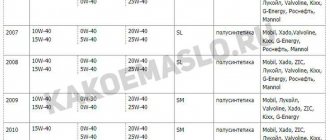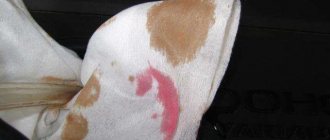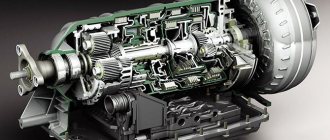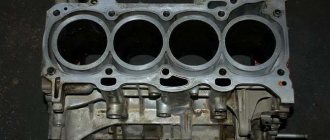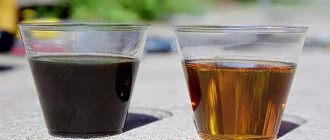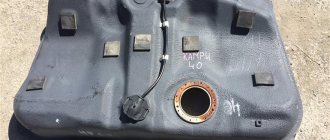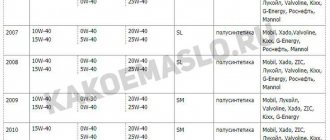The degree of wear of individual components of the Toyota Camry V50 engine largely depends on how the car is operated and maintained. First of all, care should be taken to minimize friction between metal elements and maintain optimal operating temperature. The main principle of extending engine life is to use high-quality engine oil and change it regularly.
Owners of Toyota Camry 50, when it’s time for maintenance, often ask themselves the question - which oil is better to choose?! It is also worth considering that the viscosity of the oil affects its proper operation, because pouring the wrong oil into the engine may result in unstable operation, for example, rougher operation of the engine is observed.
Engine 2.0
For the 1AZ-FE engine, which is equipped with the Toyota Camry 50 2.0 ACV51, the following types of API oils categories SL, SM, SN or ILSAC universal engine oil are most suitable. Recommended viscosity: SAE 0W-20, 5W-20, 5W-30 and 10W-30, as well as universal API motor oil category SL, SM or SN: SAE 15W-40 and 20W-50.
But you don’t need to fill in the first thing you find on the counter with the specified viscosity. The manufacturer only recommends using oil with which the engine will operate properly under certain conditions (hot or very cold climates). In most cases, for the climate prevailing in the CIS countries, the best choice would be oil with a viscosity of 0W-20, 0W-30, 5W-20, 5W-30.
The manufacturer does not play a special role, the only important thing is not to purchase a fake. The most reputable brands worth noting are Amsoil, Idemitsu, NGN, Petro-Canada, Shell or original Toyota oil.
After restyling, the 1AZ engine was replaced by 6AR-FSE (Camry V55) and when choosing oil for this engine, it is recommended to follow the same recommendations as for 1AZ (depending on conditions), but first of all it is necessary to use 0W-20 oil, which recommended for this motor.
How often should you change the oil?
Toyota has developed an oil change schedule for the Camry, which is 20 thousand kilometers. But in some cases this figure can be adjusted downwards - for example, when operating in harsh climatic conditions. In this case, the replacement frequency will have to be reduced to 10-12 thousand kilometers. Thanks to this, the oil will not have time to become unusable, and the engine will last much longer.
The most popular articles on the site:
- How often should you change engine oil?
- Oil 5w30 and 5w40 what is the difference
- What oil to pour into the engine in winter and summer
- How long does it take to change the automatic transmission oil?
Engine 2.5
The manufacturer recommends filling the Toyota Camry 50 2.5 ASV50 - 2AR-FE engine with 0W-20 engine oil. It is also permissible to use oils of other viscosities 0W-30, 5W-20, 5W-30.
As in the case of the 2.0 engine, it is necessary to take into account the region and climate zone in which the car is used and choose the best oil for the Camry engine by viscosity. In some cases and depending on the ambient temperature, it is permissible to use 0W-20 oil all year round, in other cases it is necessary to pour 5W-30 in summer and 0W-20 in winter. "30" oil will also be a better choice if the engine is subjected to more frequent loads.
Owners of Camry V50 2.5 prefer the following proven motor oils:
- Gulf Ultrasynth X 0W-20
- Amsoil Signature Series 100% Synthetic 0W-20
- Original Toyota 0W-20 (hard can)
- Idemitsu Zepro 0W-20 GF5
- Mobil 1 0W-20 Advanced Fuel Economy USA
- Motul 8100 Eco-lite 0W-20
- NGN Future 0W-20
- Xenum Nippon Energy 0W-20
- Petro-Canada Supreme Synthetic 0W-20 API SN
- Shell Helix Ultra 0W-20 API SN
- Wolf Ecotech 0W-20 FE
- United Eco Elite 0W-20
In what cases is it necessary to urgently change the oil?
Let us highlight several main factors and signs by which you can judge the condition of the engine oil:
- The oil has become unusable if it contains dirt deposits, soot, dirt and metal shavings
- The oil has become unusable if it smells burnt and has a dark brown tint.
- The gearbox is unstable, there may be delays when changing to the next speed
- Increased fuel consumption
- When you press the gas to the floor, the engine does not develop maximum speed
- Noises and vibrations in the transmission and engine, shaking is transmitted to the steering wheel
- The general perception of driving a car changes for the better and for the worse.
- Unpredictable frequency of gearbox and internal combustion engine breakdowns
- Increased oil consumption
How much to pour
| 2.0 1AZ | 2.0 6AR | 2.5 2AR | 3.5 2GR | |
| With filter: | 4.3 | 4.4 | 4.4 | 6.1 |
| Without a filter: | 4.1 | 4.1 | 4.0 | 5.7 |
The data is indicated for a complete oil change in the system, for example after a major overhaul. When changing the oil, fill in less than what is indicated in the table, since a small amount of oil remains in the pan during the change. For example, instead of 4.4 liters, it is possible to fill 3.6-3.7 liters.
How to change oil in Toyota Camry V50
(The photo shows a 2012 car with a 4-cylinder engine) Changing the oil in the Camry V50 engine is a periodic procedure that is best done independently. Moreover, changing the oil and oil filter with your own hands is quite simple.
To change the engine oil in a Toyota Camry V50, you will need: new engine oil, an oil filter, a new gasket for the drain plug, a container for used oil and a funnel, gloves and glasses, an oil filter puller, wrenches, a jack and stops.
The procedure for changing the oil is as follows:
- Gain access to the underbody of the car.
- Unscrew the oil filler cap. You will need a 14mm socket.
- Unscrew the drain plug, preparing a container for the drained oil in advance.
- Drain all oil.
- Screw in the drain plug. First by hand, and then by tightening it with a wrench.
- Unscrew the oil filter cap.
- Screw in the tool to drain the oil from the filter.
- Drain the oil from the filter.
- Unscrew the tool.
- Unscrew the filter using a puller.
- Remove the oil filter.
- Remove the old filter.
- Remove the old O-ring from the oil filter housing.
- Put on a new ring.
- Install the new filter into the housing.
- Place the cover on and remove the old O-ring.
- Install a new ring.
- Screw on the lid.
- Clean the oil filter seat.
- Install the oil filter.
- Tighten the filter using the same puller.
- Fill with new oil.
- Screw on the lid.
- Start the engine and let it run for a while.
- Check for oil leaks.
- Check the oil on the dipstick and add, if necessary, to the optimal level.
Sources:
https://www.drive2.ru/l/6479157/
https://etlib.ru/report/746-zamena-masla-tojota-kamri-v50
https://toyota-camry-corolla.ru/dvigateli/maslo-tojota-kamri-kakoe-zalivat-kak-otlichit-original/
Video: instructions for replacing a 2.5 engine
All the recommendations given above are also relevant for other Toyota models, since they were equipped with the same engines as the Camry 50.
| Model | Engine & Volume | Year of issue |
| Avalon XX30, XX40 | 2GR 3.5 | 2004-2015 |
| Avensis Verso | 1AZ 2.0 | 2001-2009 |
| Camry XV30 | 1AZ 2.0 | 2001-2006 |
| Camry XV40 | 2GR 3.5 | 2006-2011 |
| Camry XV70 | 6AR 2.0 | since 2017 |
| Harrier XU30 | 2GR 3.5 | 2003-2013 |
| Highlander XU40, XU50 | 2AR 2.5/2GR 3.5 | 2007-2017 |
| RAV4 CA20, XA20 | 1AZ 2.0 | 2000-2005 |
| RAV4 XA30 | 1AZ 2.0/2GR 3.5 | 2005-2014 |
| Venza GV10 | 2AR 2.5/2GR 3.5 | 2008-2016 |
| Lexus RX270 AL10 | 2AR 2.5/2GR 3.5 | 2012-2015 |
| Lexus ES200 XV60, XV70 | 6AR 2.0 | since 2015 |
| Lexus ES350 XV60 | 2GR 3.5 | 2015-2018 |
| Toyota Alphard H20/H30, Blade E150, Estima AHR20, XR50, Mark X Zio NA10, Picnic XM20, Sienna XL20/XL30, Vanguard XA30, Vellfire H20/H30 | ||
Considering that on our roads it is not uncommon to see cars imported from abroad (Europe, USA, Asia, Japan), above is a complete list of modifications produced in different periods for different countries.
- TOYOTA oil
- Oil for Camry
- Engine oil for Toyota Camry XV50
Maintenance schedule for Toyota Camry V50
Maintenance schedule for Toyota Camry V50
| Toyota Camry maintenance regulations . Replace and/or check the car according to the regulations and you are guaranteed reliable operation of the car. |
| № | List of works | 10 t. km | 20 t. km | 30 t. km | 40 t. km | 50 t. km | 60 t. km | 70 t. km | 80 t. km | 90 t. km | 100 t. km | |
| 1 | Checking valve clearance (2.4L engine only) | P | ||||||||||
| 2 | Drive belts - check, adjustment | P | P | P | P | P | ||||||
| 3 | Engine oil | h | h | h | h | h | h | h | h | h | h | |
| 4 | Engine oil filter | h | h | h | h | h | h | h | h | h | h | 2,0:2,5:3,5: |
| 5 | Engine cooling system, engine coolant, antifreeze - check | P | P | P | P | P | P | P | P | P | p/ z | |
| 6 | Power steering, windshield and headlight washer fluid - checking the level | P | P | P | P | P | P | P | P | P | P | |
| 7 | Radiator - checking cleanliness, checking hose connections and their correct location, corrosion, etc. | P | P | P | ||||||||
| 8 | Exhaust systems - leak testing | P | P | P | P | P | ||||||
| 9 | Spark plug | every 100,000 km | 2.0l: 2.5l: 3.5l: | |||||||||
| 10 | Battery - checking charge, electrolyte level and density, terminal condition | P | P | P | P | P | P | P | P | P | P | |
| 11 | Fuel filter | h | 2.0l: 2.5l: 3.5l: | |||||||||
| 12 | Air filter | P | h | P | h | P | h | P | h | P | h | 2.0l: 2.5l: 3.5l: |
| 13 | Fuel tank cap, fuel lines - check | P | P | P | ||||||||
| 14 | Fuel vapor adsorber - check | P | P | |||||||||
| 15 | Brake system - checking the brake pedal, condition of brake pads, discs, calipers, parking brake lever travel, absence of leaks, condition of pipelines, hoses, connections, cylinders, cleaning and lubrication of brake mechanisms | P | P | P | P | P | P | P | P | P | P | |
| 16 | Parking brake - check | P | P | P | P | P | ||||||
| 17 | Brake fluid - check, replacement | P | P | P | h | P | P | P | h | P | P | |
| 18 | Checking the Clutch Fluid | P | P | P | P | P | P | P | P | P | P | |
| 19 | Steering - check for leaks, play, condition of boots, ease of rotation of the steering wheel | P | P | P | P | P | ||||||
| 20 | Drive shafts and drive shaft boots - check | P | P | P | P | P | P | P | P | P | P | |
| 21 | Suspension joints, joint boots, wheel bearing play - check | P | P | P | P | P | P | P | P | P | P | |
| 22 | Automatic transmission (AT) - fluid check | P | p/z | |||||||||
| 23 | Automatic transmission (CVT) CVT - fluid check | P | p/z | |||||||||
| 24 | Tires - checking condition and pressure | P | P | P | P | P | P | P | P | P | P | |
| 25 | External and internal lighting devices, sound signals, windshield wipers and washers - check | P | P | P | P | P | P | P | P | P | P | |
| 26 | Cabin filter | P | h | P | h | P | h | P | h | P | h | |
| 27 | Air conditioning systems - checking operation and refrigerant level | P | P | P | P | P |
Types of oils
Finally, let’s look at the three most popular types of motor oils.
- Synthetic is a modern oil that is resistant to low temperatures. It has a high degree of fluidity, and due to this it never freezes in frosty weather. This fact allows you to use the oil not only in summer, but also in winter. Recommended for modern cars with low mileage. Ideal for Toyota Camry.
- Mineral is the worst of all existing oils. It has a low degree of fluidity and is therefore suitable for older cars with a high risk of oil leaks. Due to its excessive thickness, “mineral water” will never flow out even through a microcrack. Perhaps this is the only advantage of mineral oil, along with its low price.
- Semi-synthetic - includes a mixture of synthetic and mineral oils. It is suitable as a replacement for the mineral composition, as it is superior to it in many ways. This is a more modern and high-quality product. It can be recommended for modern cars with low mileage. So, for Toyota Camry it is best to choose synthetic oil, and semi-synthetic oil takes second place.
Among the best brands of motor oils, we note Lukoil, Castrol, ZIK, Mobile, Elf, G-Energy and others.
Source
